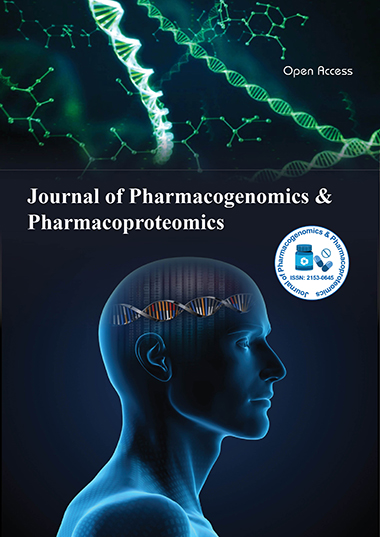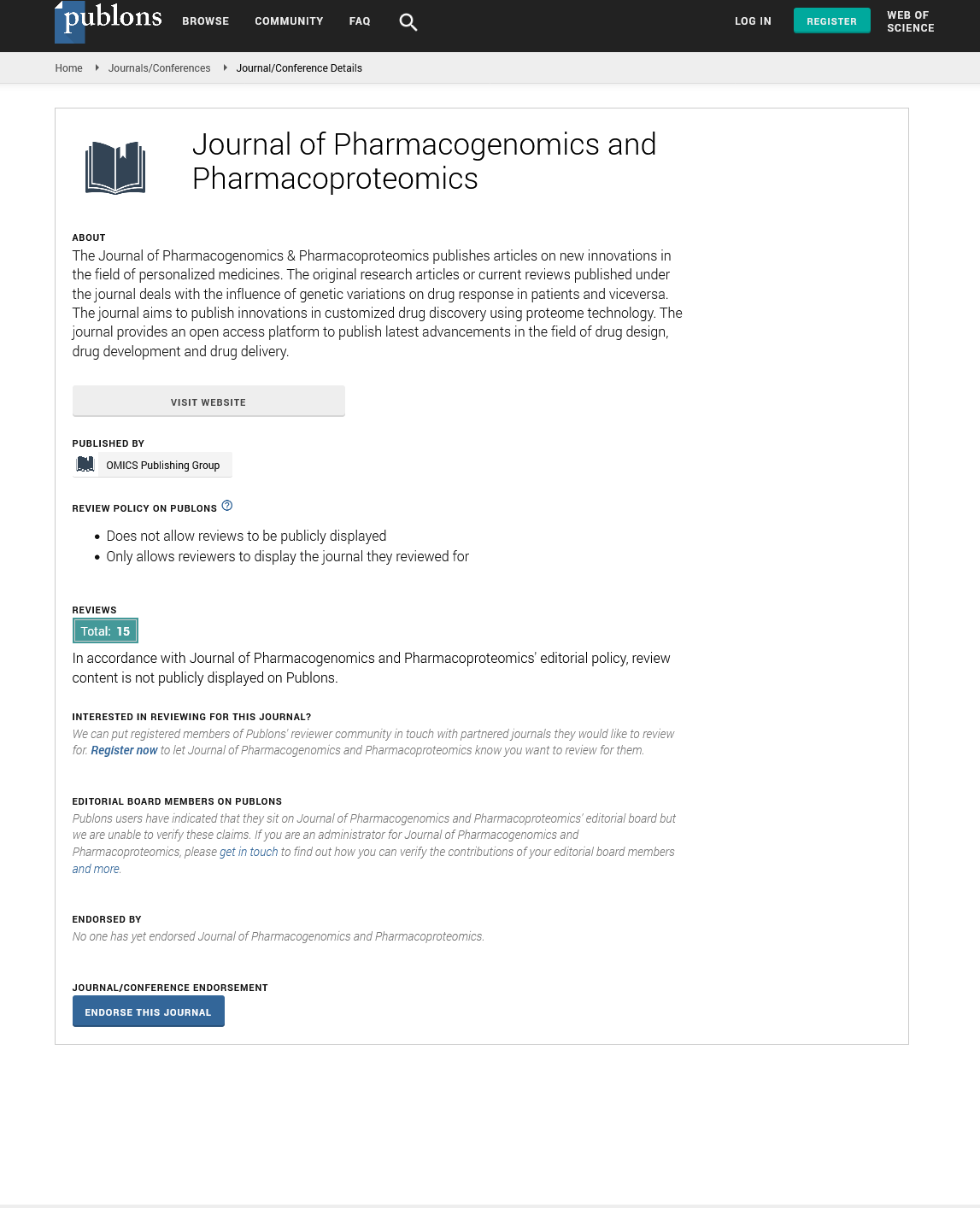Indexed In
- Open J Gate
- Genamics JournalSeek
- Academic Keys
- JournalTOCs
- ResearchBible
- Electronic Journals Library
- RefSeek
- Hamdard University
- EBSCO A-Z
- OCLC- WorldCat
- Proquest Summons
- SWB online catalog
- Virtual Library of Biology (vifabio)
- Publons
- MIAR
- Euro Pub
- Google Scholar
Useful Links
Share This Page
Journal Flyer

Open Access Journals
- Agri and Aquaculture
- Biochemistry
- Bioinformatics & Systems Biology
- Business & Management
- Chemistry
- Clinical Sciences
- Engineering
- Food & Nutrition
- General Science
- Genetics & Molecular Biology
- Immunology & Microbiology
- Medical Sciences
- Neuroscience & Psychology
- Nursing & Health Care
- Pharmaceutical Sciences
Commentary - (2025) Volume 16, Issue 2
The Convergence of Pharmacogenomics and Pharmacoproteomics in Oncology Therapeutics
Matteo Ricci*Received: 02-Jun-2025, Manuscript No. JPP-25-29914 ; Editor assigned: 04-Jun-2025, Pre QC No. JPP-25-29914 (PQ); Reviewed: 16-Jun-2025, QC No. JPP-25-29914 ; Revised: 23-Jun-2025, Manuscript No. JPP-25-29914 (R); Published: 30-Jun-2025, DOI: 10.4172/2153-0645.25.16.136
Description
Cancer therapy has long been one of the most complex challenges in medicine. Unlike infectious diseases, where pathogens are relatively uniform targets, cancers arise from the patient’s own tissues and exhibit tremendous biological diversity. This diversity is seen not only between patients but also within a single tumor, which may consist of multiple subclones with distinct genetic and proteomic profiles. While pharmacogenomics has provided remarkable insight into how inherited and somatic genetic variations influence the metabolism and effectiveness of anticancer drugs, pharmacoproteomics adds another essential layer by investigating the proteins that mediate drug response, toxicity, resistance. Together, these two fields are redefining oncology and ushering in a new era of precision therapeutics.
Pharmacogenomics has already made significant contributions to oncology. The identification of polymorphisms in thiopurine S-methyltransferase, for example, has been critical in tailoring dosages of thiopurine drugs for leukemia patients to avoid life-threatening myelosuppression. Similarly, dihydropyrimidine dehydrogenase deficiency is now recognized as a major determinant of severe 5-fluorouracil toxicity. On the somatic side, mutations in genes like EGFR, KRAS, BRAF dictate whether patients with lung or colorectal cancer will benefit from targeted therapies. These discoveries have changed clinical practice, with genotyping tests becoming part of routine diagnostic workflows in major oncology centers.
Yet, the genomic story alone is insufficient. Tumors are dynamic systems that adapt under therapeutic pressure. Even when a genetic mutation predicts initial sensitivity to a drug, resistance often develops through mechanisms not directly explained by DNA changes. This is where pharmacoproteomics becomes indispensable. By studying proteins, their expression levels, post-translational modifications, interactions within signaling pathways, pharmacoproteomics captures the functional reality of tumor behavior. For instance, patients with EGFR-mutated lung cancer may initially respond well to tyrosine kinase inhibitors but later develop resistance due to proteomic changes such as upregulation of MET receptor tyrosine kinase or activation of bypass pathways like AXL. Without proteomic insights, these adaptive resistance mechanisms remain invisible.
Modern mass spectrometry platforms now enable comprehensive proteomic profiling of tumor tissues, plasma, even exosomes shed by cancer cells. Thousands of proteins can be quantified, allowing researchers to identify specific patterns associated with drug response or resistance. For example, proteomic analyses in breast cancer have revealed signatures predicting responsiveness to trastuzumab beyond HER2 gene amplification, providing an additional layer of patient stratification. Such findings demonstrate how proteomic data can refine genomic predictions, reducing the risk of under- or overtreatment.
The integration of pharmacogenomics and pharmacoproteomics is particularly powerful in immuno-oncology. While genetic biomarkers such as PD-L1 expression and tumor mutational burden are useful, they do not fully capture the complexity of immune responses. Proteomic analyses of cytokine profiles, immune checkpoint molecules, tumor-infiltrating lymphocyte proteins provide a more holistic view. By combining genomic mutations with proteomic immune signatures, oncologists can better predict which patients will benefit from immune checkpoint inhibitors, sparing others from unnecessary toxicity and expense.
Drug discovery is another domain where this integration is transformative. Traditional oncology drug development often targeted single mutations or pathways, but resistance and tumor heterogeneity limited long-term success. Now, by incorporating Pharmacoproteomic data into genomic frameworks, researchers can design drugs that account for adaptive signaling networks rather than isolated targets. This systems-level approach increases the likelihood of durable responses and may reduce the rate of resistance emergence. The convergence of pharmacogenomics and pharmacoproteomics represents a paradigm shift in oncology therapeutics. While pharmacogenomics illuminates the genetic foundations of drug response, pharmacoproteomics reveals the adaptive protein-level processes that determine therapeutic success or failure. Together, they provide a comprehensive framework for precision medicine, guiding drug selection, predicting resistance, facilitating the development of novel therapies. The road ahead will require overcoming technical, financial, ethical challenges, but the destination—a more effective, personalized, humane approach to cancer treatment—is within reach.
Citation: Ricci M (2025) The Convergence of Pharmacogenomics and Pharmacoproteomics in Oncology Therapeutics. J Pharmacogenom Pharmacoproteomics. 16:136.
Copyright: ©2025 Ricci M. This is an open-access article distributed under the terms of the Creative Commons Attribution License, which permits unrestricted use, distribution and reproduction in any medium, provided the original author and source are credited

